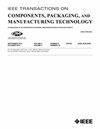Failure Analysis on Abnormal Cracking of Flip-Chip Au Bumps During the High Temperature and Humidity Testing
IF 2.3
3区 工程技术
Q2 ENGINEERING, ELECTRICAL & ELECTRONIC
IEEE Transactions on Components, Packaging and Manufacturing Technology
Pub Date : 2024-10-29
DOI:10.1109/TCPMT.2024.3487639
引用次数: 0
Abstract
Fine-pitch flip-chip Au bumps play a critical role in interconnecting and packaging advanced optoelectronics, historically known for their good corrosion resistance and high reliability. However, this study reveals the susceptibility of Au bumps to corrosion and cracking during高温高湿测试中倒装芯片金凸块异常裂纹的故障分析
本文章由计算机程序翻译,如有差异,请以英文原文为准。
求助全文
约1分钟内获得全文
求助全文
来源期刊

IEEE Transactions on Components, Packaging and Manufacturing Technology
ENGINEERING, MANUFACTURING-ENGINEERING, ELECTRICAL & ELECTRONIC
CiteScore
4.70
自引率
13.60%
发文量
203
审稿时长
3 months
期刊介绍:
IEEE Transactions on Components, Packaging, and Manufacturing Technology publishes research and application articles on modeling, design, building blocks, technical infrastructure, and analysis underpinning electronic, photonic and MEMS packaging, in addition to new developments in passive components, electrical contacts and connectors, thermal management, and device reliability; as well as the manufacture of electronics parts and assemblies, with broad coverage of design, factory modeling, assembly methods, quality, product robustness, and design-for-environment.
 求助内容:
求助内容: 应助结果提醒方式:
应助结果提醒方式:


